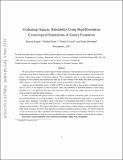Evaluating galactic habitability using high-resolution cosmological simulations of galaxy formation
Abstract
We present the first model that couples high-resolution simulations of the formation of local group galaxies with calculations of the galactic habitable zone (GHZ), a region of space which has sufficient metallicity to form terrestrial planets without being subject to hazardous radiation. These simulations allow us to make substantial progress in mapping out the asymmetric three-dimensional GHZ and its time evolution for the Milky Way (MW) and Triangulum (M33) galaxies, as opposed to works that generally assume an azimuthally symmetric GHZ. Applying typical habitability metrics to MW and M33, we find that while a large number of habitable planets exist as close as a few kiloparsecs from the galactic centre, the probability of individual planetary systems being habitable rises as one approaches the edge of the stellar disc. Tidal streams and satellite galaxies also appear to be fertile grounds for habitable planet formation. In short, we find that both galaxies arrive at similar GHZs by different evolutionary paths, as measured by the first and third quartiles of surviving biospheres. For the MW, this interquartile range begins as a narrow band at large radii, expanding to encompass much of the Galaxy at intermediate times before settling at a range of 2–13 kpc. In the case of M33, the opposite behaviour occurs – the initial and final interquartile ranges are quite similar, showing gradual evolution. This suggests that Galaxy assembly history strongly influences the time evolution of the GHZ, which will affect the relative time lag between biospheres in different galactic locations. We end by noting the caveats involved in such studies and demonstrate that high-resolution cosmological simulations will play a vital role in understanding habitability on galactic scales, provided that these simulations accurately resolve chemical evolution.
Citation
Forgan , D , Dayal , P , Cockell , C & Libeskind , N 2017 , ' Evaluating galactic habitability using high-resolution cosmological simulations of galaxy formation ' , International Journal of Astrobiology , vol. 16 , no. 1 , pp. 60-73 . https://doi.org/10.1017/S1473550415000518
Publication
International Journal of Astrobiology
Status
Peer reviewed
ISSN
1473-5504Type
Journal article
Description
D. F. acknowledges support from STFC consolidated grant ST/J001422/1, and the ‘ECOGAL’ ERC Advanced Grant. P. D. acknowledges the support of the Addison Wheeler Fellowship awarded by the Institute of Advanced Study at Durham University. N. I. L. is supported by the Deutsche Forschungs Gemeinschaft (DFG).Collections
Items in the St Andrews Research Repository are protected by copyright, with all rights reserved, unless otherwise indicated.

